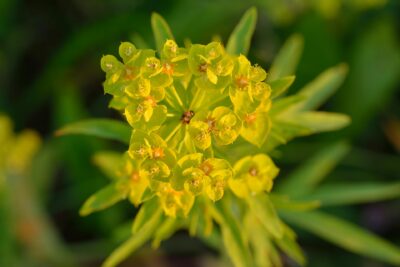By Blaine Bug Crew

With the best of summer also comes the worst. In the noxious weed category, that could most definitely be leafy spurge. This weed loves the climate of Idaho’s backcountry and is a constant threat to native species. This weed is already well established in the mountains north of Fairfield. Hopefully, the information we give you today will help you identify this invasive species if you come across it.
Leafy spurge is a deep-rooted, aggressive, persistent perennial that reproduces vegetatively and by seed. Plants have an extensive root system that grows horizontally and is capable of reaching depths of up to 20 feet. Stems are thickly clustered and have narrow, alternate leaves that exude a milky latex when damaged. This milky substance can blind you if you get it in your eyes.
The flowers are small and yellowish-green and are enclosed in showy yellow-green bracts. Seeds are oblong and occur in clusters of three. When the seeds are dry, the capsules shatter and spread the seeds as far as 15 feet from the plant. Leafy spurge is commonly found in grassland and rangeland habitats, but is also capable of invading forests and riparian areas, displacing native vegetation. This plant is poisonous to horses, cattle, and wildlife. Luckily, the Blaine Bug Crew has an insect predator that feeds on leafy spurge.
Adult Oberea erythrocephala have red heads, black eyes, and slender bodies with antennae that are nearly as long as the body. Males emerge several days before females and both sexes are sexually immature for two weeks before they start mating. Females often girdle the upper part of the stem, gnaw a hole into the stem above the girdle, and deposit an egg into the hole from the end of June to mid-July. Each female can produce approximately 60 eggs during her lifetime.
Larvae hatch 10 days after eggs are laid and feed in leafy spurge stems on the pith, tunneling downward to the root crown where they remain during the winter. Mined stems dry, wilt and do not produce flowers or seeds. Crown and root feeding reduces the plant’s root reserves and allows pathogenic fungi to enter infested leafy spurge roots. Oberea erthrocephala prefers moist areas with trees and can survive subfreezing winter temperatures.
As one can gather from this article, leafy spurge is extremely noxious and aggressive. One interesting note about this weed is the fact that goats love it. They think it is candy and they suffer no ill effects from eating it. Herds of goats have even been employed in steep drainages in Idaho’s backcountry to try to stop the spread of this invader.
If you see an infestation of this weed in your travels, please call Kay Draper with the Blaine County Weed Department at (208) 788-5543.


